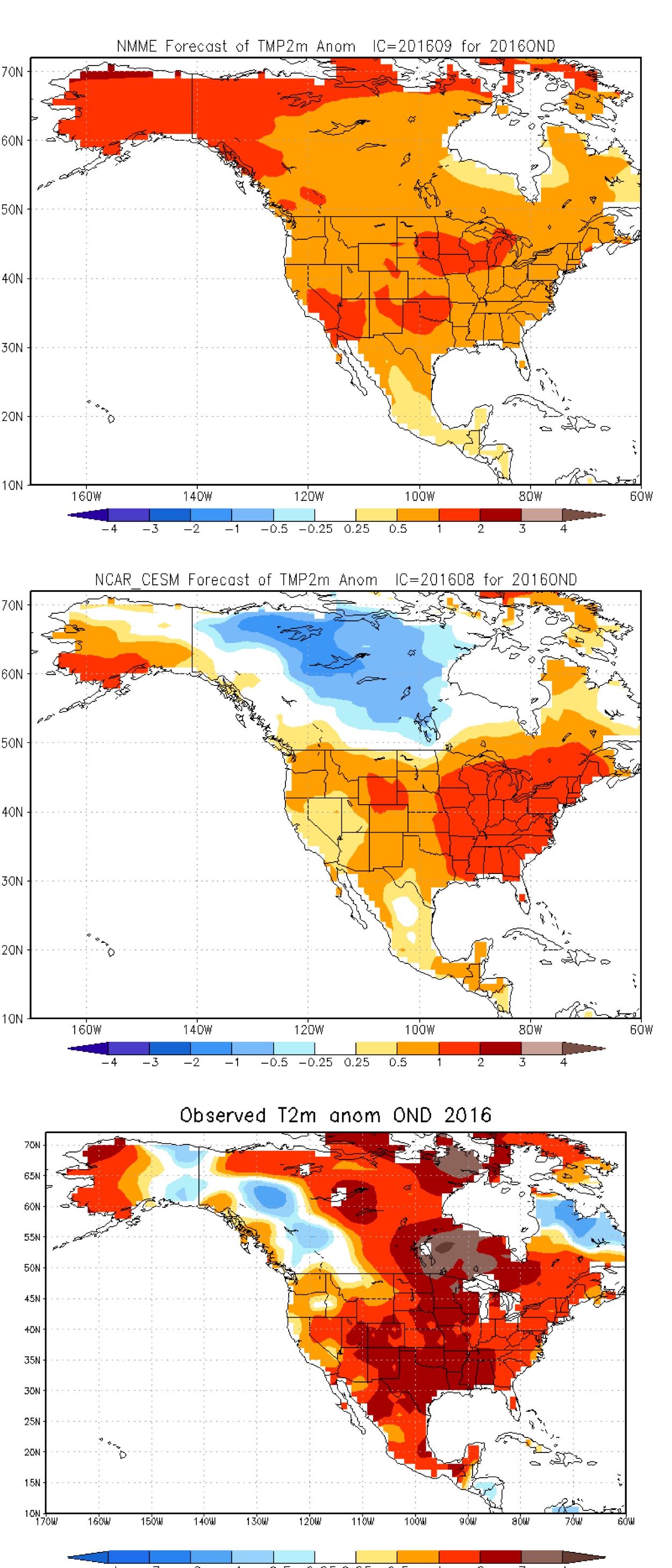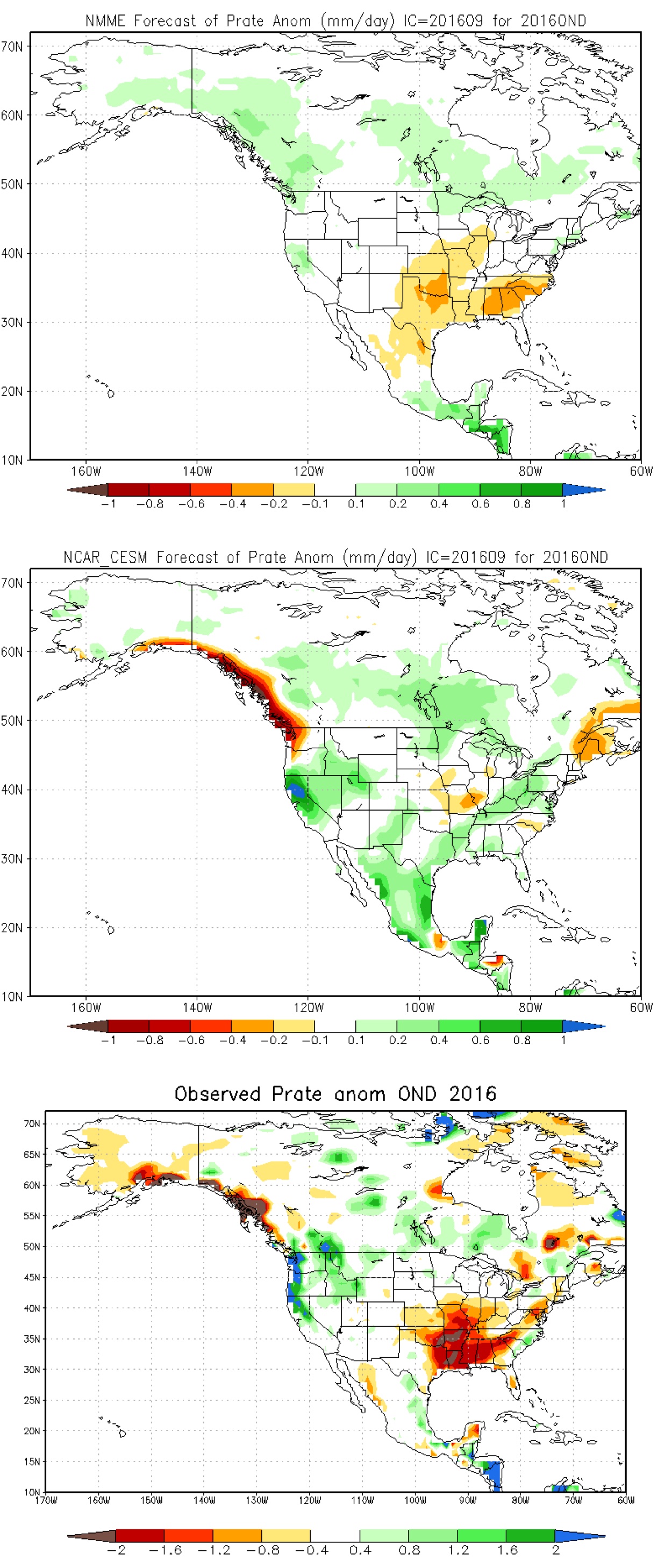NCAR-based climate model joins seasonal forecasting effort
A suite of North American models is filling the prediction gap between weeks and decades
Jan 12, 2017 - by Staff
Jan 12, 2017 - by Staff
January 12, 2017 | An NCAR-based computer model known for global climate projections decades into the future recently joined a suite of other world-class models being used to forecast what may lie just a few months ahead.
The Community Earth System Model has long been an invaluable tool for scientists investigating how the climate may change in the long term — decades or even centuries into the future. Last summer, CESM became the newest member of the North American Multi-Model Ensemble (NMME), an innovative effort that combines some techniques typically used in weather forecasting with those used in climate modeling to predict temperature and precipitation seasons in advance. The result is a bridge that helps span the gap between two-week forecasts and decades-long projections.
 The forecasted temperature anomalies (departures from average) over North America made by the entire NMME suite (top) and by CESM (middle). Observed temperature anomalies for the same period (bottom). Click to enlarge. (Images courtesy NOAA.)
The forecasted temperature anomalies (departures from average) over North America made by the entire NMME suite (top) and by CESM (middle). Observed temperature anomalies for the same period (bottom). Click to enlarge. (Images courtesy NOAA.)
But NMME also builds another bridge: this one between operational forecasters, who issue the forecasts society depends on, and researchers. Now a collection of nine climate models, the NMME has proven it produces more accurate seasonal forecasts than any one model alone. It was adopted in May by the National Oceanic and Atmospheric Administration (NOAA) as one of the agency's official seasonal forecasting tools.
"What is so important about NMME is that it's bringing research to bear on operational forecasts," said Ben Kirtman, a professor of atmospheric sciences at the University of Miami who leads the NMME project. "The marriage between real-time prediction and research has fostered new understandings, identified new problems that we hadn't thought about before, and really opened up new lines of research."
Weather models and climate models have a lot of things in common; for one, they both use mathematical equations to represent the physical processes going on in the atmosphere. Weather models, which are concerned with what’s likely to happen in the immediate future, depend on being fed accurate initial conditions to produce good forecasts. Even if a weather model could perfectly mimic how the atmosphere works, it would need to know what the atmosphere actually looks like now — the temperature and pressure at points across the country, for example — to determine what the atmosphere will look like tomorrow.
Climate modelers, on the other hand, are often interested in broad changes over many decades, so the exact weather conditions at the beginning of a simulation are usually not as important. In fact, their impact is quickly drowned out by larger-scale trends that unfold over long time periods.
In recent years, however, scientists have become interested in whether climate models — which simulate changes in ocean circulation patterns, sea surface temperatures, and other large-scale phenomena that have lingering impacts on weather patterns — could be initialized with accurate starting conditions and then used to make skillful seasonal forecasts.
The NMME project is exploring this question. The global climate models that make up NMME project are all being initialized monthly to create multiple forecasts that stretch a year in advance. Along with CESM, those models include the NCAR-based Community Climate System Model, Version 4, which is being initialized by Kirtman's team at the University of Miami. (See a full list of models below.)
Taken together, the individual model forecasts reveal information to forecasters about the amount of uncertainty in the seasonal forecast. If individual forecasts vary substantially, the future is less certain. If they agree, forecasters can have more confidence.
 The forecasted precipitation anomalies (departures from average) over North America made by the entire NMME suite (top) and by CESM (middle). Observed precipitation anomalies for the same period (bottom). Click to enlarge. (Images courtesy NOAA.)
The forecasted precipitation anomalies (departures from average) over North America made by the entire NMME suite (top) and by CESM (middle). Observed precipitation anomalies for the same period (bottom). Click to enlarge. (Images courtesy NOAA.)
CESM's first seasonal forecast as part of NMME, which was issued for July, August, and September 2016, was perhaps the most accurate of any in the ensemble. The forecast — which called for conditions to be warmer and drier than average across most of the United States — was issued after more than a year of work by NCAR scientists Joseph Tribbia and Julie Caron.
All of the models in the NMME suite must be calibrated by running "hindcasts." By comparing the model's prediction of a historical season with what actually happened, the scientists can identify if the model is consistently off in some areas. For example, the model might generally predict that seasons will be wetter or cooler than they actually are for certain regions of the country. These tendencies can then be statistically corrected in future forecasts.
"We ran 10 predictions every month for a 33-year period and ran each prediction out for one year," Tribbia said. "You can learn a lot about how your model performs when you have so many runs."
Once CESM was calibrated, it joined the NMME operational suite of models. But the data generated by the rigorous hindcasting process wasn't cast aside once the calibration was finished. Instead, every modeling group has saved not only monthly data, but also high-frequency daily data that are being stored at NCAR.
The trove of historical predictions, along with the new predictions being generated in real-time, are an incredible resource for scientists interested in improving the techniques for initializing climate models and exploring what types of things can, and cannot, be predicted in advance.
"Predictability research can be a challenge. The NMME dataset allows you to check yourself in a robust way," Kirtman said. "If you think you've found a source of predictability in the hindcast mode, you can then try to do it in real time. It's really exciting — and it really holds your feet to the fire."
This year, as much as 18.5 terabytes of NMME data were downloaded from NCAR monthly, according to NCAR's Eric Nienhouse, who oversees the data archive.
Now that CESM is an active part of NMME, Tribbia and Caron will also be diving into the data.
"Now the fun begins," Caron said. "We get to start looking at the data to see how we're doing, and what we might change in the future to make our seasonal forecasts better."
NCEP CFSv2: National Centers for Environmental Prediction Climate Forecast System Version 2 (NOAA)
CMC1 CanCM3: Canadian Meteorological Centre/Canadian Centre for Climate Modeling and Analysis
CMC2 CanCM4: Canadian Meteorological Centre/Canadian Centre for Climate Modeling and Analysis
GFDL FLOR: Geophysical Fluid Dynamics Laboratory Forecast-oriented Low Ocean Resolution (NOAA)
GFDL CM2.1: Geophysical Fluid Dynamics Laboratory Coupled Climate Model Version 2.1 (NOAA)
NCAR CCSM4: National Center for Atmospheric Research Community Climate System Model Version 4
NASA GEOS5: NASA Goddard Earth Observing System Model Version 5
NCAR CESM: National Center for Atmospheric Research Community Earth System Model
IMME: National Centers for Environmental Prediction International Multi-Model Ensemble (NOAA)
Writer/contact:
Laura Snider, Senior Science Writer